List of spacedocks in orbit of Earth.
Named[]
- Orbital Drydock Facility
- Starbase 1 (alternate reality)
- Orbital office complex
- Spacedock One
- NAR-30974
- McKinley Station
- San Francisco Fleet Yards
Unnamed []
21st century space station []
A station in close orbit around Earth. The OV-165 space shuttle could dock and be fueled on this station. (Star Trek: Enterprise opening titles)
Columbia spacedock []
This spacedock was the location for the construction of Columbia NX-02, the second NX-class starship, in 2153 and 2154.
The spacedock was made up of three cage segments that were wider than the segments that made up the Orbital Drydock Facility, where Enterprise NX-01 was launched from. Instead of having four circular lights in each row on the cage segments, this station had eight rectangular lights that were grouped more closely together. The dorsal sections of the cage supported a small windowed station in the center of the facility as well as rails that three movable construction arms attached to. Housed in the center joint on either side of the sections that made up the walls of the cage were small stations.

Columbia ready in spacedock in 2154, with the stations' doors closed
Each station supported a large cargo/shuttlebay facing inwards and had two airlocks located at the bow and stern, one facing outwards along the centerline where other segments could be added, and one facing inwards towards where the ship would be located. These bays sported one large door. (ENT: "The Expanse", "Home", "Affliction")
Columbia was launched from this spacedock in late November 2154. (ENT: "Affliction")
Enterprise spacedock []
This spacedock was the second known spacedock to service the starship Enterprise and was operational for at least some of the time that Columbia was in drydock. It was of the same configuration as the Columbia facility except, instead of having eight lights per row, this dock only had seven.
After returning from the Xindi mission, Enterprise underwent repair work in this spacedock before moving to the Orbital Drydock Facility before or in May 2154. (ENT: "Home")
Earth spacedocks[]
These interconnected spacedocks were located in a high orbit over Earth.
In 2259, the USS Enterprise underwent refit at this facility. Also in the dock at the time were Shepard-class, Malachowski-class, Nimitz-class, and Farragut-type starships. (SNW: "Strange New Worlds")
USS Enterprise spacedock []
This drydock was where the USS Enterprise underwent a refit in the early 2270s, at which time the dock was supervised by both a dock control and yard command. (Star Trek: The Motion Picture) There were at least two cargo or shuttlebays located at the bow end of the dorsal section of the station, as well as several large working lights at various points along the sides of the "cage" facing inwards. (Star Trek: The Motion Picture; Star Trek II: The Wrath of Khan) In 2285, the Enterprise again launched from this dock on a training cruise shortly before the Battle of the Mutara Nebula. (Star Trek II: The Wrath of Khan)
USS Enterprise-E spacedock []
This spacedock was where the USS Enterprise-E was repaired in 2379, following the Battle in the Bassen Rift. A small station was located in the center of the dorsal section of the spacedock, and was able to connect to the shuttlebay in the primary hull of a Sovereign-class starship. (Star Trek Nemesis)
Appendices[]
Background information[]
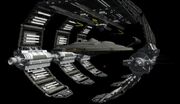
A basic CGI render of the Columbia spacedock
Doug Drexler was not entirely happy with the Earth drydocks of Star Trek: Enterprise. "While I thought the drydocks were well done," he clarified, "I would have made them part of a larger yard encompassing a space office\transportation and residence hub, a supply yard-warehouse complex, and more local traffic. It all boiled down to the limits of a television schedule, and budget." Drexler also personally preferred Star Trek: Enterprise's three-fingered spacedock variant more than the series' five-fingered one. He opined, "The more modest three finger arrangement is more in keeping with the shows time frame, and smaller less sophisticated starship." [1](X) Explaining why a slightly different spacedock was created for housing Columbia NX-02, John Eaves said, "It was just to show difference. We all hate to see shots and elements reused and called something new and different when it's in fact not, so being conscious of this the Eden [FX] boys added the extra time to make something new exclusive for the NX-02." [2]
USS Enterprise spacedock info []
The spacedock featured in Star Trek: The Motion Picture was absent from an August 1977 story treatment for the film's never-produced precursor, "In Thy Image". (Lost Voyages of Trek and The Next Generation, p. 28) The idea of the dock was suggested later that month, as the treatment circulated among the production team hired for the eventually-canceled television series Star Trek: Phase II (for which "In Thy Image" was intended to be the pilot episode). (Star Trek Phase II: The Lost Series, p. 33) As such, the dock features in a 20 October 1977 first-draft script for "In Thy Image". (Star Trek Phase II: The Lost Series)
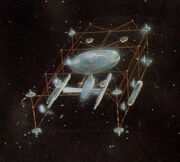
A web-like drydock designed for Star Trek: Phase II
A web-like mesh, representing this drydock, was included in a concept painting that illustrator Michael Minor created. (The Art of Star Trek, p. 153) Andrew Probert, who worked as a production illustrator on The Motion Picture, later noted, "On Mike Minor's concept [of] the dock, he had rocket nozzles on the corners of the drydock for maintaining orbital position." [3] Mike Minor also illustrated a variety of elevations exploring the dock. By 8 September 1977, Minor had finished the various elevations and had turned them over to model builders Magicam, who were awarded the contract for building the majority of the studio models in September 1977. (Star Trek Phase II: The Lost Series, pp. 43 & 44; Starlog #27, p. 26)
In October 1977, the studio model for Phase II's Earth spacedock was frequently tinkered with but remained unfinished. (Star Trek Phase II: The Lost Series, p. 49) Due to a change of location for Magicam headquarters, the drydock was one of several Phase II models whose completion date was delayed to 4 November 1977, as post-production supervisor Paul Rabwin reported to producer Robert Goodwin on 14 October of that year. (Star Trek Phase II: The Lost Series, p. 51)
Gene Roddenberry wanted the spacedock to be in a geosynchronous orbit above the city of San Francisco. (text commentary, Star Trek: The Motion Picture (The Director's Edition)) Although this was written into a script draft of "In Thy Image" with the dock having a height of 200 miles, story editor Jon Povill sent a memo (on 14 October 1977) to the writer of the episode's script, Harold Livingston, that refuted this proposition. "I was asked to check with Jesco [Jesco Von Puttkamer, NASA Technical Adviser to the production] as to what orbital height was necessary in order to maintain a synchronous orbit over San Francisco," Povill wrote. "It turns out that the only height at which a synchronous orbit can be maintained is 22,000 miles." (Star Trek Phase II: The Lost Series, p. 51) Livingston's revised first-draft script, submitted on 20 October 1977, duly altered the height to "several hundred miles." (Star Trek Phase II: The Lost Series, pp. 51 & 131) Since the vast distance of 22,300 miles from the Earth would have made the planet seem like only a small ball, the dock's altitude was thereafter again lowered. (text commentary, Star Trek: The Motion Picture (The Director's Edition))
In November 1977, the research company de Forest Research suggested that the references to "drydock" in the script for "In Thy Image" be replaced with "spacedock". (Star Trek Phase II: The Lost Series, pp. 62-63 & 64)
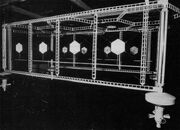
The studio model for Phase II's spacedock
Phase II's drydock model was evaluated, by Paul Rabwin and Robert Abel, as being "the best looking of all the models" built for the planned television series. (Star Trek Phase II: The Lost Series, p. 72) In hindsight, however, Andrew Probert commented, "The [...] design was a box, with a very Earthbound look to it." (Starlog #32)
Due to the increased resolution demands of feature film photography, the drydock model had to be rebuilt from scratch, along with all the others constructed for Phase II. (Star Trek Phase II: The Lost Series, pp. 70 & 71) In December 1977, Paul Rabwin contacted Robert Goodwin with suggestions from Robert Abel about how to upgrade the models, including the drydock. "Perhaps embellish elevators... 'busy' it up a little more," noted Rabwin. "A new section of drydock should be built... the top and one side, so that angles from the side can be photographed." These plans were considered as possible assignments for Magicam. (Star Trek Phase II: The Lost Series, p. 72) In accordance with further advice from Abel, the drydock model was photographed while containing the unfinished Phase II Enterprise studio model. (Star Trek Phase II: The Lost Series, pp. 72 & 71)
As it was decided to start over from scratch as far as the drydock studio model was concerned, the Phase II miniature – which was almost ready for an even-more delayed delivery date of 5 February 1978 – was discarded. (Starlog #27, p. 29; American Cinematographer, January 1980, p. 153; Star Trek: Creating the Enterprise, p. 46) At a party held to commemorate the drydock model and the other Phase II miniatures prior to trashing them, the unsuccessful dock model (along with the original Enterprise model) was hung over a massive eight-foot by twelve-foot elevator table, on which lobster was meanwhile served for the production team. (Star Trek: Creating the Enterprise, p. 46)
The Motion Picture's screenplay refers to this structure as an orbital drydock. The main concept artwork featuring this drydock was created by Andrew Probert. (The Art of Star Trek, p. 172) Revising the concepts for the drydock constituted his first assignment for the film. "We aimed for a design that would look like an extension of current NASA thinking for zero-g fabrication," he said. (Starlog #32) Probert studied Mike Minor's dock designs before starting work on reworking them. (The Special Effects of Trek, p. 29)
During Andrew Probert's tenure on the drydock design, the earliest idea for the facility was to have it, in Probert's words, "fit the shape of the Enterprise as snugly as possible." (Starlog #32) Hence, in some of his earliest concept sketches for the dock, the facility was more closely fitting to the exterior of the ship than it ultimately became. Probert stated, "My thinking was that the closer the dry dock is to the ship it's working on, you know, the more easier it would be for equipment and personnel to get down to the surface... or up to the surface!" [4] Probert initially envisioned the drydock as having the capability of expanding, a function that was not shown in the film. He commented, "I had actually envisioned four or five other drydocks in orbit nearby, servicing other starships of various sizes and shapes, and that would have shown how flexible the design was." [5] (Look here to view early concept artwork for The Motion Picture's orbital office complex, from which two sketches include the multiple, close-fitting drydocks.) Probert also experimented with the lighting of this dock configuration and created designs for cranes that were to be operated by workers laboring on the docked ships. [6]
By or in April 1978, the spacedock was changed to having a more box-like shape, much as it appears in the final film. (The Art of Star Trek, p. 172) Another of Andrew Probert's initial ideas was for the station to have a side hub that would serve as essentially a garage for workbees and include office areas as well as living quarters. [7](X) This feature was detailed in at least two concept paintings, one of which was dated April 1978. Another design feature that was included in the same illustration (as well as in a separate group of concept sketches) was a concourse, intended to physically link the dock with the rim of the Enterprise's saucer section. (The Art of Star Trek, p. 172; [8](X)) Probert also initially envisaged expanding on Mike Minor's idea of having rocket nozzles as part of the dock. "I thought we could update that with some sort of an energy beam," explained Probert. [9]
A concept painting from July 1978 included even more modifications on the dock's design. For example, the single side hub had been replaced with the pair of cargo/shuttlebays seen in the film. (The Art of Star Trek, p. 172) Compared to Mike Minor's dock, the drydock Probert came up with was more open and less similar to a building's interior. (The Special Effects of Trek, p. 29) (Some of Andrew Probert's concept artwork for the dock can be viewed here(X), while an audio and visual presentation – with Probert commenting on these illustrations – can be accessed here).
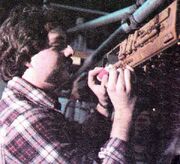
Ross detailing the drydock model
The studio model used for the new redesigned The Motion Picture spacedock was also built at Magicam, who were actually retained as the primary studio model building company. (The Art of Star Trek, p. 173) It was the last studio model the company embarked upon, partly because Magicam's staff was, up until then, knee-deep involved with the construction of the revised eight-foot Enterprise model, partly because redesigned elements of the drydock kept coming in, and partly because it took months to put together thousands of parts needed to assemble the model, which was only half in jest dubbed "the kit" by Jim Dow. (Starlog #27, p. 29) The model maker who was appointed lead modeler for the build of the miniature was Magicam employee Russ Simpson, heading a team that involved, among others, Chris Ross. [10] Costing US$250,000, the drydock model was four feet high, six feet wide, and ten and a half feet deep. It had fifty-six neon panels that required 168,000 volts of electricity. (The Making of Star Trek: The Motion Picture, p. 210) The neon lighting was installed by a sub-contracted specialist, Larry Albright, whereas the more conventional incandescents were installed by Magicam's own Paul Turner. (American Cinematographer, February 1980, p. 178) Each of these six-by-six-inch neon grids required three thousand volts of electricity to operate, so each neon tube had a transformer which provided the power via large cables. Magicam completed the drydock over a span of five months, constructing it with half-inch glass tubing twisted into shapes by an aerospace tube bender facility. The tubing supported thousands of small wires. (Trek: The Unauthorized Story of the Movies, pp. 29 & 28) The model was constructed out of nearly 100,000 custom-made parts, many of which plastic, and came in at 350 pounds, when delivered for filming. (American Cinematographer, February 1980, pp. 178-179)
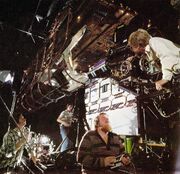
The model of this drydock being readied on a stage at Future General Corporation
Douglas Trumbull, who directed The Motion Picture's special photographic effects, devised ideas to both improve and simplify the lighting and filming of the drydock model. He also supervised the photographing of the model. (The Making of Star Trek: The Motion Picture, p. 206) This filming was initially intended to be done on Paramount Stage 2. (The Making of Star Trek: The Motion Picture, p. 215) However, one of Trumbull's stages at Future General Corporation ultimately served as one of the filming sites, if not the only one. (The Making of Star Trek: The Motion Picture, interior color photographs & p. 206) On-stage preparations for filming the model involved special effects technicians Bob Spurlock, David Gold, Pat van Auken, Dave Stewart and Jonathan Seay. (The Making of Star Trek: The Motion Picture, interior color photographs) Cameraman David Hardberger also contributed to the preparations. (Cinefex, issue 1, p. 10) Transformers supplying the vast amounts of battery power needed to run the miniature's neon panels were positioned on a separate table. (The Making of Star Trek: The Motion Picture, p. 210) Daren Dochterman – visual effects supervisor for Star Trek: The Motion Picture (The Director's Edition) DVD – remarked, "The dry-dock itself was shot in front of what's called a front-light/backlight process, meaning it's not blue screen, but they would shoot one pass with a brightly lit background and no lights on the foreground. And then they would do the same pass with the models lit correctly. And the bright pass would serve as a matte to insert stars or the Earth behind it. And in this way, they could much more carefully craft the lighting on the miniatures rather than have to worry about blue from the blue screens. So, this allowed them to get some amazing shots with a Snorkel camera." (audio commentary, Star Trek: The Motion Picture (Blu-ray))
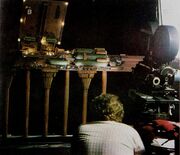
The enlarged partial model filmed by Stewart
At least one other partial model was built for the dock, used in close-ups of one side of the facility. This model was larger and considerably more detailed than the main miniature of the dock. (audio commentary, Star Trek: The Motion Picture (Blu-ray)) Construction of the model was deemed necessary for those instances where it was felt that adequate depth of field could not be obtained by using the combination of both full-size miniatures. The footage shot of the detail model was, in post-production, matted over that of the Enterprise. (Cinefex, issue 1, p. 12)
For its appearance in Star Trek II, the dock was scripted to be shown via recycled footage from The Motion Picture. [11] This was also how the dock was represented in the actual film version of the sequel. (text commentary, Star Trek: The Motion Picture (The Director's Edition) DVD; et al.) The amount of footage of the dock was minimized, though. Mike Minor recalled, "We worked out a way [...] [of] cutting that interminable 'look-at-us-aren't-we-great-special-effects-people' trip around the Enterprise spacedock." (Enterprise Incidents, issue #14, p. 51)

Similar drydocks at Utopia Planitia
The studio model for this drydock was heavily modified for use as the Starfleet drydock in Star Trek Generations. [12][13] When it came time to create the newer type of spacedock, the model for The Motion Picture version was sent to Industrial Light & Magic. Years later, ILM Visual Effects Supervisor John Knoll related, "I remember when the model got shipped up here and we opened up the crate, looked at it, that was a special moment for me." ("Industrial Light & Magic – The Next Generation", Star Trek: First Contact (Blu-ray)) Reusing the model as Starbase 375 was an option for the visual effects artists who worked on Star Trek: Deep Space Nine, though they ultimately opted to use a different model. (Cinefantastique, Vol. 30, No. 9/10, p. 35) Drydocks of both types used in The Motion Picture and Generations were additionally located at the Utopia Planitia Fleet Yards above Mars in the 24th century, as shown in the Star Trek: Voyager episode "Relativity". Neither variation shown in that episode was a physical model but rather a CGI model, constructed at Foundation Imaging under the supervision of Adam Lebowitz. (Star Trek: The Magazine Volume 1, Issue 6, p. 50) Brandon MacDougall was the modeler responsible for constructing the CGI version of the drydock in its original configuration. [14]
USS Enterprise-E spacedock info []
Very few structural details about this spacedock from Star Trek Nemesis were included in the film's shooting script, which describes its inner enclosure as merely "the great womb of a spacedock." [15]

The second concept sketch that John Eaves created for the dock
The final exterior design for this spacedock was created by production illustrator John Eaves, who described the dock as "a fun piece to work on." [16] Eaves took his inspiration for the spacedock from the earlier drydock shown in The Motion Picture. Shortly after working on Nemesis, Eaves commented about the spacedock, "The new one is still very open, because we're flying across the surface of it and you really want to see the Enterprise from the outside of the dock, as well as the inside; but what we tried to do with this one was make it unique for the Enterprise – a custom port for that sovereign class of ship." (Cinefex, No. 93, p. 111) Eaves later remembered, "At Paramount, we had come up with some Space Dock designs, and they were not too much of a high point with importance visually, so they went through the approval process with only one cosmetic change. The top of the dock had a considerably large living complex, and the producers opted for a minimal area, [so] as to keep the frame work more open. Sketch two did this, and the final part of the dock was the docking coupler [....] This [spacedock] was to be a broader design as to accommodate more [than] just the 'E', but there was little concern for these details based on the secret fact that this was to be the last TNG film." [17]
Meanwhile, Digital Domain artist Darryl Anka had also been given the task of designing the spacedock, unbeknownst to John Eaves. As Eaves delivered his concept sketches of the dock from Paramount to Digital Domain, he discovered Anka's connection to the project. "We received the fax of Darryl's drawing," stated Eaves, "which was a cool design that mixed a little bit of the original and the dock created for the NX-01. Seeing the name on the bottom is how I found out that Darryl was on the show too! Sadly, his idea was presented too late to get in the run." Despite this, the spacedock in Star Trek: Nemesis includes a worker pod design that Darryl Anka did successfully contribute. [18] Furthermore, it was Digital Domain who actually visualized John Eaves' artwork on-screen, creating a virtual model of the spacedock based on his concept art. (Cinefex, No. 93, p. 111)
Regarding the docking coupler which (in the movie) links the dock with the Enterprise-E, John Eaves admitted, "You don't really get a clear view of that little feature unless you know what your looking for!" [19]




